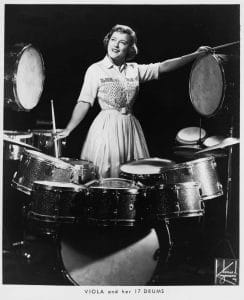Growing up in Wisconsin, Smith (at the time, Viola Schmitz) had seven sisters and two brothers, and all trained on the piano. Their father came up with the idea of creating an all-girl musical act, the Schmitz Sisters Family Orchestra. As the sixth child, Viola didn’t have a lot of choice of instruments to play in the band: Irene chose trombone, Erma vibraphone, Edwina got dibs on the trumpet, Lila the sax, Mildred the bass violin, Loretta the piano, and Sally on bass sax, so Viola ended up on the drums. It was an excellent choice: she went on to be one of the most famous jazz and swing drummers of the era.

Viola was billed as the “fastest girl drummer in the world,” she played for the NBC Symphony Orchestra, Ella Fitzgerald, Bob Hope, Chick Webb, and appeared five times on The Ed Sullivan Show. She turned down an offer to join Woody Herman’s Thundering Herd band to play with the Coquettes, an all-female group (see video below). When she was held up as the “female Gene Krupa” (a famous jazz drummer known for his solo on Benny Goodman’s “Sing, Sing, Sing” in 1937), Smith retorted that Krupa was the “male Viola Smith.” Indeed, Smith was known for “speaking out for female musicians,” said Angela Smith (no relation), author of Women Drummers: A History from Rock and Jazz to Blues and Country. Smith “gave other women the courage and chops to break the barriers of what was once an all-too-male field.”
In 1942, “Smith sent shock waves through the jazz world by claiming in Down Beat magazine that ‘hep girls’ could sit in any jam session and hold their own,” Angela Smith wrote. “Viola paved the way for so many female drummers,” the Ludwig Drums company agreed in a statement, “and was still playing at 107 years old! She was a true innovator.” Smith served as the company’s ambassador for some time, as well as for the Zildjian cymbal company. She retired from professional play in the mid-1970s, and died October 21 at her home in Costa Mesa, Calif., from Alzheimer’s disease. She was 107.
